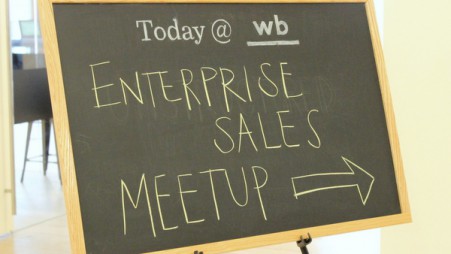A Sales-Cycle Acceleration Framework
I’ve written quite a bit about the topic of creating a sense of urgency in a sales process. See here, here and here. This is an enormously important issue for high growth startups as the timing of when sales will close impacts, among other things, investor expectations and perception, salesforce efficiency, financial performance, cash management and when sales commissions are paid. Sales pipeline review meetings often include more discussion about when specific deals will close as opposed to if specific deals will close.
Before any discussion of creating urgency can happen, two things must occur: 1.) the seller must understand the buyer's priorities and how those priorities line up (or don't line up) with the seller's product and 2.) the seller must have a detailed understanding of the buyer's buying process and all of the stakeholders that need to be involved in getting a deal to closure. Once these things are understood, sellers can begin to think about how to create urgency and shorten the length of a sales cycle.
Good sales organizations will use a variety of tactics to accelerate a sales process; from the use of detailed ROI documents to help the buyer prioritize one project over another to offering discounts in return for a speedier close. There’s really no end to the number of tactics that can be used to create urgency and more predictable sales results. I’ve created the framework below to help sales organizations brainstorm solutions to this problem and come up with new tactics.
Here's how to think about the framework. On the X-axis are seller focused versus buyer focused urgency tactics. In most cases, a seller wants to align urgency with what’s important to the buyer. That is, the seller wants to help the buyer understand the cost of the problem of not having the seller’s product and quantify the impact of not having that product. Good sellers will frequently remind the buyer of the value being missed by not having the product in place. It’s also ideal for the seller to line up a close date with a particular event that's important to the buyer (e.g. a life insurance seller lining up their close date with the buyer’s benefits open enrollment period). These are generally the most effective ways to drive urgency.
That said, while a seller always wants a buyer to be moving fast because it’s inherently good for the buyer, this doesn’t always have to be the case. The seller and buyer are on an equal playing field. The seller may have reasons why they want to move a deal faster than the buyer. Obviously, in some cases, the buyer may not care about the seller's priorities but I would encourage sellers to be transparent about them anyway. Recently, a salesperson was trying to sell me more software for my sales team and he told me he’d give me a substantial discount if I bought sooner rather than later. I asked him why he would sacrifice a lot of revenue for an earlier close and he was very transparent about the fact that his company's fiscal quarter was coming to a close and they had a revenue number to hit. As the buyer, I genuinely appreciated this transparency and he was able to get his sale. I don't support the use of tricks or dishonesty to get sellers buy quickly, but I absolutely support sellers being extremely transparent about their priorities.
The Y-axis outlines qualitative versus quantitative tactics.
Quantitative tactics are those tactics that are driven by a financial impact to the seller or the buyer. On the buyer side this is the revenue that will be gained or the costs that will be reduced from buying the product; e.g. every day that goes by that the product isn’t in place the buyer is losing X dollars. On the seller side, this is about the value to the seller that comes if the deal closes sooner rather than later. This can be the ability for the seller to use idle resources, or the importance of hitting a sales target, or simply the fact that revenue today is worth more than revenue tomorrow.
Qualitative tactics, on the other hand, are more art than science. These are things like the quality of the relationship between the buyer and the seller, the emotional components of the product (e.g. the seller will 'look good' to certain stakeholders if they buy) and the fact that a competitor is using the product and the buyer is not. Qualitative urgency is fun to talk about because it’s a place where sellers can get really, really creative.
Two final thoughts:
First, there are dozens of hooks that will drive urgency within this framework. Those listed above aren't appropriate for every organization. And when brainstorming it's important to get multiple stakeholders involved to come up with as many hooks as possible. Many of them may be totally unique to an individual organization.
Finally, I generally believe that sellers want to spend most of their time focused on the top-right quadrant. Ultimately, quantifiable, buyer-focused value is the most scalable and sustainable way for an organization to grow. But it doesn’t work every time on every deal. Selling into large organizations can get incredibly complex. The best sellers combat complexity with creativity. I hope the framework above helps sales organizations do just that.




